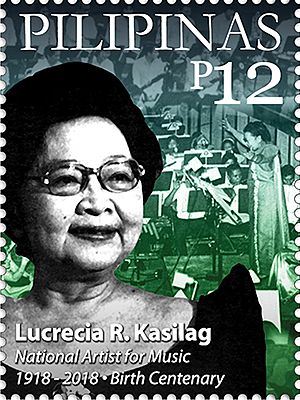Lucrecia Roces Kasilag facts for kids
Lucrecia Roces Kasilag (born August 31, 1918 – died August 16, 2008) was a famous Filipino composer and pianist. She was known for using traditional Filipino instruments in her big orchestral music pieces. This made her music unique and special.
Contents
About Lucrecia Kasilag
Lucrecia Roces Kasilag was often called "King" by her friends and family. She was born in San Fernando, La Union, Philippines. She was the third of six children. Her father, Marcial Kasilag, Sr., was a civil engineer. Her mother, Asuncion Roces Ganancial, was a violinist and taught violin.
Early Life and Education
Lucrecia's mother was her first teacher for solfeggio. This is a way of learning music by singing notes. Later, she studied with other teachers. When she was ten, Lucrecia performed her first public piano piece. It was called May Breezes by Felix Mendelssohn.
Lucrecia grew up in Paco, Manila, where she went to Paco Elementary School. She was the top student when she finished in 1930. She then went to Philippine Women's University for high school and also graduated as the top student in 1933.
For college, she stayed at the same university. In 1936, she earned a Bachelor of Arts degree in English with honors. She also studied music at St. Scholastica's College Manila in Malate, Manila. She earned a Music Teacher's Diploma in piano in 1939.
Music Career and Contributions
During World War II, Lucrecia started composing music. On December 1, 1945, she performed her own compositions in a concert. From 1946 to 1947, she taught music at the University of the Philippines. She also worked as a secretary at Philippine Women's University.
She earned another degree, a Bachelor of Music, in 1949. After that, she went to the Eastman School of Music in New York, USA. There, she studied music theory and composition.
When she returned to the Philippines in 1953, she became the Dean of the College of Music and Fine Arts at Philippine Women's University.
Lucrecia Kasilag also toured internationally as a concert pianist. However, she had to stop performing because of a weakness in one of her hands.
She played a very important role in developing Filipino music and culture. She started the Bayanihan Folks Arts Center. This center helped research and present traditional Filipino arts. She was also deeply involved with the famous Bayanihan Philippine Dance Company.
She was also the former president of the Cultural Center of the Philippines. She led the Asian Composers League and was Chairperson of the Philippine Society for Music Education. Lucrecia Kasilag wrote more than 350 musical pieces. These included everything from folksongs to operas and orchestral works. She continued composing almost until she passed away at age 89.
Lucrecia Roces Kasilag died from pneumonia on August 16, 2008, in Manila, Philippines.
Famous Musical Works
Lucrecia Kasilag created many different types of music. Here are some of her well-known works:
Works for Stage
These are musical pieces meant to be performed on a stage, often with dancing or acting.
- Dularawan: Salakot na Ginto (Image Play: The Golden Salakot) (1969)
- Her Son, Jose, an operatorio (a type of opera) (1977)
- The Spiritual Canticle, an operatorio (1991)
- Filiasiana, a choral dance kaleidoscope (1964)
- Sisa, a ballet (1976)
- Why Flowers Bloom in May, an opera (2008)
Concertos
Concertos are pieces for a solo instrument (like a violin or piano) playing with an orchestra.
- Violin Concerto no. 1 (1983)
- Violin Concerto no. 2 (1994)
- Divertissement for Piano and Orchestra (1960)
Choral Music
These are pieces written for a choir to sing.
- Misang Pilipino (Filipino mass) (1966)
- De Profundis (1977)
- Benedictus, a cantata (a piece for voices and instruments) (1990)
- Ode to the President (1995)
Orchestral Works
These are big pieces written for a full orchestra.
- Ang Pamana (The Heritage) (1966)
- The Legend of Sarimanok (1963)
- In the Beginning (1988)
- Centennial Tribute to Filipino Womanhood, a symphonic cycle (1998)
Chamber and Solo Music
Chamber music is for a small group of instruments. Solo music is for one instrument.
- Derivations I-V, for piano (1961, 1963, 1966, 1969, 1982)
- Toccata, for Percussion and Winds (1958)
- Dialogue for Western Flutes and Pinoy Flutes (1996)
- Prelude Etnika and Toccata, for guitar (1996)
- Sonata Orientale, for piano (1961)
- Scherzino, for piano (1980)
- Rondeau, for piano (1981)
- Elegy on Mt. Pinatubo, for piano (1992)
- Serendipity, for piano (1994)
Music for Traditional Instruments
These pieces use instruments native to the Philippines or other Asian countries.
- Improvisations no. 2, for Muslim gamelan (an Indonesian instrument set) and tipangklong (a Filipino bamboo instrument) (1970)
- Ang Apoy ng mga Hayop (The Fire of Animals), a musical tale (1986)
Awards and Recognition
Lucrecia Kasilag received many honors for her amazing contributions to music and culture.
- Patnubay ng Sining at Kalinangan Award in Music, 1954
- Presidential Award of Merit as Woman Composer, 1956
- Presidential Award of Merit and Gold Medal for Leadership and Outstanding Contribution to Music and the Arts, 1960
- Republic Cultural Heritage Award in Music for her works Toccata for Winds and Percussion (1960) and Misang Pilipino (1966)
- Honorary Doctor of Music from Centro Escolar University, 1975
- Honorary Doctor of Laws from the Philippine Women’s University, 1980
- Honorary Doctor of Fine Arts from St. John’s University in New York, 1981
- She was named a National Artist of the Philippines in 1989. This is the highest honor given to Filipino artists.
- Outstanding Filipino Award for the Arts from Jaycee Senate International, 1991
See also
 In Spanish: Lucrecia Kasilag para niños
In Spanish: Lucrecia Kasilag para niños


